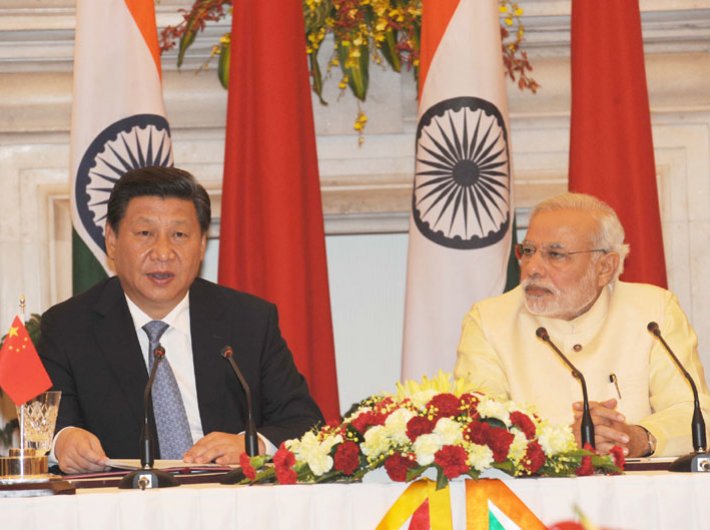Editor’s note: The author, editor (current affairs) at the Institute of South Asian Studies (ISAS), an autonomous research institute at National University of Singapore, wrote this article for our print issue dated Sept 16-30, 2014 before Chinese president Xi Jinping’s India visit.
Chinese president Xi Jinping’s prospective visit to India should help prime minister Narendra Modi calibrate India’s foreign policy calculus for the foreseeable future in a fast-changing world. The summit between Modi and Japanese prime minister Shinzo Abe in Tokyo on September 1 must have already given the Indian leader a fair idea of the emerging arc of power politics in Asia.
In geographical and geopolitical terms, China is at the centre of this emerging Asian arc that covers India and Japan as well, with the US as the ‘resident’ external power. So, Modi’s likely meeting with president Barack Obama before the end of September will virtually complete the Big Picture of Asia-centred globalised world for the immediate purposes of India’s foreign policy. Obviously, India’s engagements with Russia, Europe, and the rest of the world will also be relevant to New Delhi, going forward. On balance, however, Xi’s imminent visit to India can turn into the strategic moment that Modi can usefully seize to position India suitably in the emerging Asia-centred global order.
This does not mean that a blueprint of a new Indian foreign policy can be outlined at the conclusion of Xi’s visit. But Modi should, by then, be able to begin a process of refashioning India’s foreign policy, with particular reference to the Indo-Pacific and Asia-Pacific regions.
Xi and Modi have already met on the sidelines of the BRICS (Brazil, Russia, India, China, and South Africa) summit in Brazil on July 14. As a result, an attempt to reconfigure the Sino-Indian dialogue is already under way. This is evident from the Chinese and Indian official accounts of the Xi-Modi talks in Brazil in July. Some of these evident aspects are: On the bilateral side, talks on the border dispute will continue, while the trade imbalance will be addressed through a firm focus on Chinese investments in India in the possible form of “exemplary” Sino-Indian projects. Such a trade-investment linkage is relatively new, because China has now promised to increase investments in India, and also signalled readiness to be more receptive to Indian services.
A substantially novel aspect of the Sino-Indian agenda pertains to multilateral and global issues. China has now expressed a clear intent to consider giving India a rightful place in such forums as APEC (Asia-Pacific Economic Cooperation). India has also been invited to associate itself with China as a founding member of the proposed Asian Infrastructure Bank. Moreover, Xi is keen that India should partner with China to set new global economic norms.
For New Delhi, however, there is no indication yet from Beijing that it might be ready to consider yielding a rightful place to India in the global strategic-and-security domain. China is far from imagining India as a veto-empowered fellow-permanent-member of the UN Security Council, if it is to be expanded. The Council is the global chamber that seeks to solve international security crises.
It is in these circumstances that an Asian arc of power politics is beginning to take shape. Three factors driving this process are: (1) Beijing’s transparent efforts to set security-and-economic rules for Asia and beyond, (2) the enduring China-Japan tensions, and (3) the unsettled Sino-Indian equation. The fragile but not frosty Sino-Indian equation, in all its aspects, will have to be addressed in this context. So, the prospective Xi-Modi summit, which might be focused considerably on the current realities in the Sino-Indian bilateral relationship, can also turn into a strategic moment for the future.
For now, the Sino-Indian state-to-state engagement is labelled as “Strategic and Cooperative Partnership for Peace and Prosperity”. This certainly is an impressive label. But it is not impressive enough, considering the fact that “strategic partnerships” are dime a dozen in today’s post-Cold War era of inter-state diplomacy. China’s present equation with post-Soviet Russia is labelled and defined as a qualitatively far higher form of strategic partnership. Interestingly, India’s relationship with Russia, a long-standing friend, is defined as “Special and Privileged Strategic Partnership”. This certainly matches today’s Sino-Russian equation. The fine irony in this sub-context, though, is that China had, at one stage, made common cause with the US against the old Soviet Union, whereas India has been steadfast in its ties with the Soviet Union first and Russia later.
India and Japan have recently elevated their “Strategic and Global Partnership” to the status of a “special” genre in the same category. Surely, each of the several labels cited here does matter as a generalised index of the state of play in the relevant bilateral relationship. However, each bilateral relationship will be just as strong or weak as the symmetric or asymmetric balance between the comprehensive national strengths of the two sides.
It, therefore, follows that only a strong India, in economic and military terms, can play a worthwhile international role. Modi’s exposition of this reality, with reference to Japan on September 1, shows that he recognises this. He said: “Japan will [now onwards] play an increasingly important role in India’s economic transformation and development. ... Prime Minister Abe ... has announced his intention to realise 3.5 trillion yen, or US$ 35 billion, or Rs 2,10,000 crore, of public and private investment and financing to India over the next five years. ... A successful India and a successful Japan will be of benefit to both countries. Even more, the [Indo-Japan] relationship will be a force of peace, stability and prosperity in Asia and the world.”
As a logical corollary, the comprehensive national strengths of India and China will be acutely relevant to the dynamics of the emerging Asian arc of power politics. It is common knowledge that China’s comprehensive national strength is overwhelmingly superior to India’s as of now. Unsurprisingly, the Sino-Indian bilateral trade is hugely imbalanced in favour of China. However, India can spot an unusual opportunity in Xi’s recent offer to address this trade imbalance by catalysing greater Chinese investments in India and by promoting the free flow of India’s services to China.
In a stark scenario that showcases this opportunity, New Delhi can encourage China to develop a substantive economic stake in India’s long-term political stability – far into the future. This, in turn, may induce Beijing to rein in the traditional “anti-India” inclinations of neighbouring Pakistan, China’s “all-weather friend” and New Delhi’s all-season “rival”. A counter-argument from a senior Pakistani friend is that his country, already passing through a crisis of democracy and a crisis of existential religious-identity, should not be viewed as an “anti-India” force.
However, New Delhi’s foreign-policy mandarins feel the need to reckon with a sheaf of issues in the domain of economics concerning China, India, and Pakistan. The China-Pakistan Economic Corridor, as now planned, partially passes through the disputed territory that India sees as its own. From New Delhi’s standpoint, this aspect might, over time, have military-strategic implications for India with reference to both China and Pakistan. Moreover, India will be anxious to deny China any potential military-strategic gains from the proposed Bangladesh-China-India-Myanmar (BCIM) “Southern Silk Route”.
The BCIM project, as now conceived, does not pass through “disputed territory” (from an Indian perspective). But China’s economic access to “sensitive” areas in India and also areas adjacent to India, under this project, is something that New Delhi’s strategic-affairs wizards do not ignore. Within these parameters, it is still possible for New Delhi to fully explore the option of encouraging China to gain an economic stake in India’s current and future political stability. A new opening in this regard has been made possible by China’s recent offer to step up investments in India.
For China, a matter of profound interest and concern is the possibility of India turning into a US-friendly swing-state in the Indo-Pacific and Asia-Pacific regions. As a sort of counter, therefore, Beijing has already begun to make economic overtures to New Delhi, knowing full well the strategic centrality of even a troubled Pakistan in the Sino-Indian equation.
The stabilising but fragile Sino-Indian bilateral equation can be firmed up, if at least two mindset issues are properly addressed. First, New Delhi should cease to anchor its China-oriented strategic vision in the outcome of the 1962 Sino-Indian Himalayan War, which India lost. Several major powers, including China itself, have had the historical experience of suffering military reverses and other psychological wounds. Second, China, too, should be more mindful of India’s national and global “aspirations”. A good beginning has been made in the form of Xi’s gesture of inviting India to the APEC summit which China will host later this year.
Even if these mindset issues are addressed, it is difficult to imagine that Xi and Modi could announce a final settlement of the complex Sino-Indian border dispute when they meet now. The dispute is already complicated by Beijing’s claims on India’s Arunachal Pradesh – in Chinese parlance, “southern Tibet” and, therefore, “Chinese territory”. Without discussing here the entire gamut of Sino-Indian issues, including that relating to the Brahmaputra (Yarlung Zangbo), it can be asserted that both sides should get real about themselves. They are nuclear-armed and space-faring neighbours.
Suryanarayana is editor (current affairs) at the Institute of South Asian Studies (ISAS), an autonomous research institute at the National University of Singapore. Opinions expressed in this article, based on research by the author, do not necessarily reflect the views of ISAS.
(This article appeared in the Sept 16-30, 2014 print issue of the magazine.)

